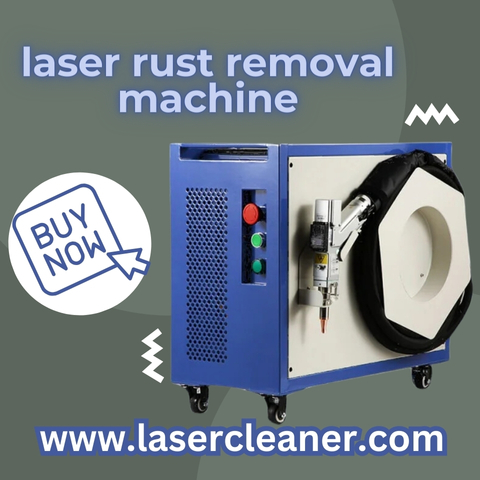In modern industries, the presence of rust on metal surfaces is not just an aesthetic issue but also a serious challenge that impacts performance, durability, and safety. Traditional rust removal methods often rely on chemicals, abrasives, or manual labor, which are time-consuming and may cause damage to the underlying material. To address these challenges, the laser rust removal machine has emerged as a highly effective solution that combines precision, speed, and reliability for industrial applications.
Understanding the Laser Rust Removal Machine
A laser rust removal machine uses concentrated laser beams to clean and strip away rust, oxides, and unwanted contaminants from metal surfaces. Instead of relying on physical abrasion or chemical reactions, this machine leverages the power of laser energy to break down rust particles and remove them without harming the base material. This principle makes it an ideal tool for industries where precision and surface integrity are crucial.
The technology is based on laser ablation, a process in which high-intensity laser light interacts with contaminants on the surface, causing them to evaporate or detach instantly. Since rust has different absorption properties compared to the base metal, the laser selectively removes it while leaving the original material untouched.
Why Industries Choose Laser Rust Removal
The laser rust removal machine has gained significant popularity across automotive, aerospace, shipbuilding, railways, electronics, and manufacturing industries. Its ability to provide non-contact cleaning ensures minimal wear on equipment, while the high level of precision reduces the risk of surface deformation.
For example, in the automotive sector, components such as chassis parts, brake systems, and frames often suffer from rust due to exposure to moisture. Instead of replacing entire parts, manufacturers now rely on laser rust removal to restore the surfaces quickly and cost-effectively. Similarly, in aerospace, where the tolerance for imperfections is extremely low, this machine ensures clean and safe surfaces before welding or painting.
How the Machine Works in Practice
When the laser beam is directed at a rusty surface, the energy is absorbed by the rust layer, which heats up rapidly. This sudden heating causes the rust to break apart, vaporize, or detach in the form of fine dust. The process is carefully controlled by adjusting the power, wavelength, and scanning speed of the laser to match the specific type of metal and degree of corrosion.
In industries where accuracy is critical, operators can fine-tune the laser rust removal machine to remove only microns of material, ensuring the base metal remains intact. For larger-scale projects, automated systems allow the machine to clean wide areas in a short amount of time, making it suitable for ship hulls, pipelines, and industrial machinery.
The Role of Laser Rust Removal in Sustainability
One of the most significant reasons for the rapid adoption of laser rust removal technology is its environmentally friendly approach. Unlike chemical cleaning methods that require acids or solvents, a laser rust removal machine produces no toxic waste. The process generates only small amounts of dust, which can be collected using extraction systems.
This sustainable approach not only reduces environmental impact but also improves workplace safety. Workers are no longer exposed to harmful chemicals or excessive dust from sandblasting, which has long-term health implications. By using laser cleaning, industries achieve compliance with environmental regulations while maintaining high productivity.
Applications Across Different Sectors
- Automotive Manufacturing and Repair
Car frames, engine parts, and panels often suffer from rust, especially in older vehicles. With a laser rust removal machine, manufacturers and workshops can restore metal parts to their original condition, preparing them for welding, coating, or painting. - Aerospace Industry
Aircraft components require high-precision cleaning before assembly. Laser cleaning ensures that no residues remain, which could otherwise affect bonding strength or cause failures during operation. - Shipbuilding and Marine Maintenance
Ships and offshore structures face constant exposure to saltwater, leading to severe corrosion. A laser rust removal machine can clean hulls, decks, and pipelines without using abrasive blasting, significantly extending their service life. - Electronics and Electrical Equipment
In the electronics sector, precise cleaning is required to remove oxides from connectors, wires, and contact points. Lasers provide a controlled and efficient cleaning solution without damaging delicate components. - Railway Infrastructure
Rails, bridges, and metal structures used in the railway industry benefit from laser cleaning during maintenance, ensuring longer service life and improved safety.
Integration With Modern Manufacturing Systems
Many modern factories are adopting automated systems where laser rust removal machines are integrated into production lines. Using robotics and computer numerical control (CNC) systems, manufacturers can achieve consistent and repeatable results on a large scale.
This integration also reduces downtime since the machine requires minimal maintenance compared to traditional cleaning equipment. Industries that adopt this technology often report significant improvements in efficiency and cost savings over time.
Long-Term Value for Businesses
Investing in a laser rust removal machine is not only about immediate cleaning results but also about long-term operational benefits. Companies reduce their dependency on consumables such as sand, chemicals, or replacement parts. They also lower their labor costs since laser cleaning requires less manual effort.
Additionally, the quality of the final product improves significantly, which boosts customer satisfaction and enhances brand reputation. Whether used in repair workshops or large-scale manufacturing plants, the machine proves to be a valuable asset that supports growth and competitiveness.
Case Example of Industrial Use
Consider a manufacturing company producing heavy machinery for construction. Traditionally, the company relied on abrasive blasting to remove rust before painting. This method required large amounts of sand, protective gear for workers, and significant cleaning afterward.
After investing in a laser rust removal machine, the company reported a 40% reduction in cleaning time, elimination of abrasive material costs, and improved paint adhesion on machinery parts. The overall operational efficiency increased, and the workplace environment became safer and cleaner.
Future of Laser Rust Removal
As technology continues to evolve, laser systems are becoming more powerful, compact, and affordable. The next generation of machines is expected to feature higher automation, artificial vision systems for surface detection, and integration with smart manufacturing processes.
The growing demand for sustainable solutions and stricter environmental regulations will likely accelerate the adoption of laser rust removal machines across industries. With these advancements, businesses can look forward to even greater levels of efficiency, safety, and cost-effectiveness.
Final Thoughts
The laser rust removal machine is transforming how industries approach surface cleaning and maintenance. By providing precise, efficient, and environmentally friendly solutions, it eliminates the limitations of traditional methods and offers long-term value for businesses. From automotive to aerospace and beyond, its role is expanding rapidly as industries recognize the importance of high-quality, sustainable surface preparation. For companies seeking to improve productivity and reduce costs while maintaining top-tier quality, adopting this technology is a forward-looking decision that ensures competitiveness in today’s industrial landscape.

